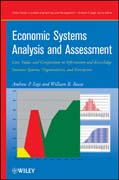
Economic systems analysis and assessment: intensive systems, organizations and enterprises
Sage, Andrew P.
Rouse, William B.
INDICE: Chapter 1. Introduction. 1.1 Inroduction. 1.2 A Framework for Systems Engineering and Management. 1.3 Theory of the Firm. 1.4 Theory of the Consumer. 1.5 The Interaction of the Theories of the Firms and Consumers: Microeconomic Models of Economic Activity. 1.6 Welfare or Normative Economics. 1.7 Program and Program Management Economics. 1.8 Contemporary Issues Concerning Information and Information Technology Economic. 1.9 Economic Pitfalls in the Engineering of Systems. 1.10 Summary. Chapter 2. Production and the Theory of the Firm. 2.1 Introduction. 2.2 The Production Function. 2.3 Multiproduct Firms andMultiproduct Production Functions. 2.4 Classical Theory of the Firm. 2.5 Imperfect Competition. 2.6 Summary. Chapter 3. The Theory of the Consumer. 3.1 Introduction. 3.2 Economic Utility Theory and Its Axioms. 3.3 Property of UtilityFunctions. 3.4 The Fundamental Problem of the Consumer. 3.5 Sensitivity and Substitution Effects. 3.6 Summary. Chapter 4. Supply Demand Equilibria and Microeconomic Systems Analysis and Assessment Models. 4.1 Introduction. 4.2 Basic Supply-Demand Equilibrium for a Single Good. 4.3 General Supply-Demand Equilibrium Conditions. 4.4 Extensions to General Equilibrium to Include Market Interdependencies. 4.5 Microeconomics Models. 4.6 Summary. Chapter 5. Normative or Welfare Economics, Decisions and Games, and Behavioral Economics. 5.1 Introduction. 5.2 Pareto Optimality Under Perfect Competitive Conditions. 5.3 ExternalEffects and Imperfect Competition-Public Goods. 5.4 External Effects and Imperfect Competition-Nonindependent Production and Consumption. 5.5 Welfare Maximization and Social Choice. 5.6 Summary. 5.7 Selected Bibliography. Chapter 6. Cost-Benefit and Cost-Effectiveness Analysis and Assessments. 6.1 Introduction. 6.2 The Time Value of Money. 6.3 Identification of Costs and Benefits. 6.4 The Identification and Quantification of Effectiveness. 6.5 A Guide to Cost-Benefit Analysis. Chapter 7. Cost Assessment. 7.1 Model Based Parameters for Productivity. 7.2 Early Models for Estimation of Costs, Including Effort and Schedule. 7.3 The Constructive Cost Model (COCOMO). 7.4 Summary. 7.5 References andBibliography. 7.6 Problems. Chapter 8. Approaches to Investment Valuation. Chapter 9. Real Options for Investment Valuation. Chapter 10. Contemporary Perspectives.
- ISBN: 978-0-470-13795-6
- Editorial: John Wiley & Sons
- Encuadernacion: Cartoné
- Páginas: 420
- Fecha Publicación: 20/05/2011
- Nº Volúmenes: 1
- Idioma: Inglés
